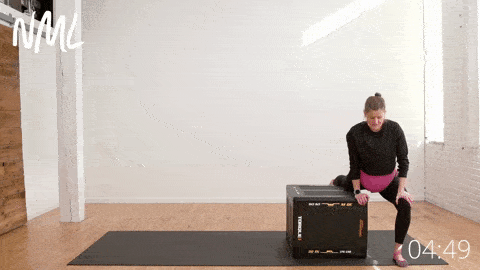 Buy Now →
Buy Now → 

Seven of the best sciatica stretches to relieve pain! This guided 10-minute stretch is designed to reduce pain in the hips, legs and low back by releasing the piriformis muscle, which can pinch the sciatic nerve. These are also great pregnancy sciatica stretches, and safe for all trimesters.
Sciatic nerve pain can be debilitating — limiting everyday movements like standing and walking.
This is my third pregnancy, and the first time I’m experiencing sciatica pain. And let me tell you – sciatic nerve pain stinks! It makes daily movements, like walking and standing, painful.
Here you’ll find seven of the best stretches for sciatica pain – designed to release tightness in the piriformis and take pressure off the sciatic nerve.
Dealing with other pregnancy aches and pains? Check out these 8 Back Pain Stretches (Pregnancy-Safe) and these 3 Exercises for SPD.

Sciatica is a form of nerve pain. It ranges from mild to severe, and radiates along the path of the sciatic nerve, which branches from your lower back through your hips and glutes, and down each leg. Sciatica symptoms are commonly described as sharp, shooting, or jolts of pain along the low back, hips and legs. Others describe this pain as a “burning,” “electric” or “tingling” sensation (Cleveland Clinic).
Sciatica most commonly occurs when a herniated disc, bone spur on the spine, or narrowing of the spine (spinal stenosis) compresses part of the sciatic nerve (Mayo Clinic).
Exercises to loosen your sciatic nerve, like a seated piriformis stretch, can reduce symptoms of sciatic nerve pain. Stretching exercises for the low back, hips and glutes can also provide relief for sciatic nerve pain.
Sciatica during pregnancy is relatively common. Hormones produced during pregnancy cause ligaments to loosen. Loosened ligaments can cause the spine to become unstable, which can lead to nerves being pinched.

Release tight muscles and relieve sciatic pain and lower back pain with this guided stretching video: the best sciatica stretches.
This was specifically developed to help women in need of pregnancy sciatica stretches, but can be used by anyone for pain relief.
Note: Stretching may feel uncomfortable, but it shouldn’t feel painful. If you feel a stretch causing pain, pull back from the stretch and lessen the range of motion to modify each pose until you gain more flexibility and mobility.
No equipment, just your bodyweight.
You can add a foam roller for move six and a tennis ball/lacrosse ball/massage ball for move seven if you have one available. We’ll also be using a bench/chair/sofa to deepen some of the stretches.

Follow along with the guided Sciatic Nerve Stretches video on YouTube, led by certified personal trainer and prenatal fitness instructor, Lindsey Bomgren.
Your Workout Looks Like This:
1. Cat-Cow Stretch
2. Seated Piriformis or Figure-4 Stretch
3. Hip Flexor Stretch with Rotation
4. Tensor Fasciae Latae (TFL) and Iliotibial (IT) Band Hip Sink
5. Puppy Dog Stretch
6. Seated Piriformis Release on Foam Roller
7. Piriformis Stretch on Massage/Lacrosse/Tennis Ball

Targets: All the muscles along your spine and releases low back tension.
The simple cat-cow pose improves blood flow between the vertebrae of your spine. Great for relieving back pain and stress tension.

Targets: Specifically the piriformis muscle — a flat, band-like muscle located in the buttocks near the top of the hip joint.
This muscle is important in lower body movement and often becomes tight and overworked during pregnancy causing sciatica pain.

Note: Normally when doing this type of stretch, we would fold forward over the bent knee (pigeon pose). This type of compression can actually make sciatic pain worse. Think “extension, not compression” when doing this stretch.
Targets: Hips, hip flexors, groin, quads, glutes, low back and core.

Targets: Tensor Fasciae Latae (TFL) and Iliotibial (IT) Band – AKA the muscles and tendons that help to extend, abduct, and rotate the hips.

Targets: Neck, shoulders, spine, upper back and lower back.

Targets: The glutes, outer glutes and piriformis muscle (a deep, small muscle located between your glutes and hip joints and it helps the hips rotate).

Targets: Specifically the piriformis muscle — a flat, band-like muscle located in the buttocks near the top of the hip joint.

 Buy Now →
Buy Now →  Buy Now →
Buy Now →  Buy Now →
Buy Now → 
This post includes affiliate links. I do earn a commission for products purchased using these links (at no additional cost to you). Thank you for supporting Nourish Move Love, making the content you see on this blog possible.